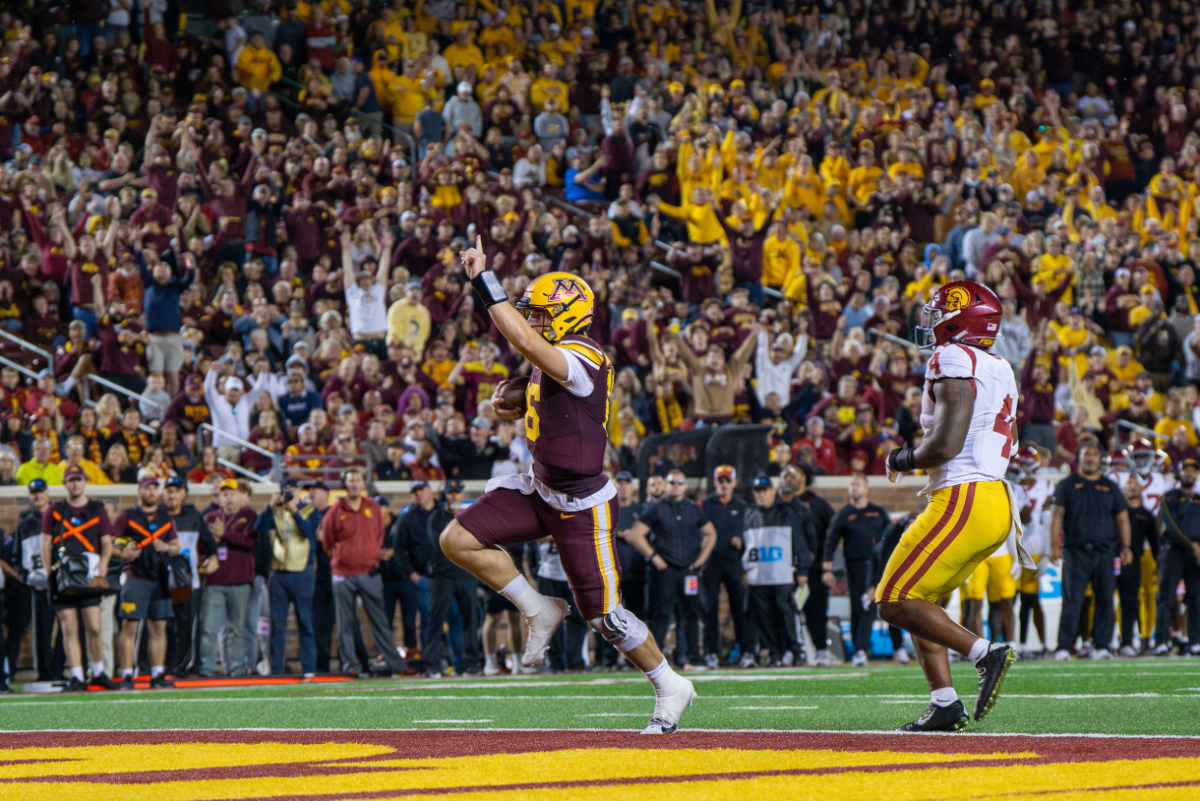More than a year after the University of Minnesota cut three men’s sports programs as a result of financial insecurity stemming from the COVID-19 pandemic, student athletes, former coaches, administrators and alumni are aiming to move forward and take action to help those most impacted by the decision.
These groups are finding alternative ways to keep the sports on campus and preserve the legacy of the programs. Numerous new clubs have started over the past year, allowing athletes to participate in competitions not affiliated with the University. Others are collaborating to raise awareness among state legislators and donors on the impact of the decision.
The decision to cut the men’s gymnastics, tennis and indoor track and field programs, approved by the Board of Regents in October 2020, was contested among students and administrators alike. Many student athletes and administrators opposed, with some protesting the decision due to the relatively low amount of money cutting the programs would save.
The elimination of these three programs annually saved $1.6 million, as the University as a whole faced a budget deficit of $172 million. The University cited the need to comply with Title IX policy as another reason for eliminating the programs.
At the September 2021 Board of Regents meeting, University of Minnesota athletics director Mark Coyle provided an update on the financial status of the athletics department and reflected on the cutting of the programs last year.
“I hope the public … and members of the board would understand we went through an extensive process and we exhausted all that we could exhaust in terms of what we needed to do, and how we needed to do it,” Coyle said.
When the sports were canceled last fall, the athletics department faced a projected financial deficit of $65 to $75 million. As a result of the revenue produced from airing football on television last year, this deficit was revised to $45 million.
As of June 2021, the athletics department still faced a $21.5 million budget deficit resulting from losses accrued due to the COVID-19 pandemic.
Coyle and the University’s athletics department declined requests from the Minnesota Daily to comment further on last year’s decision.
Loss of program opens new doors for gymnastics student athletes
Since the elimination of the programs, many student athletes at the University are finding other ways to stay engaged in their sports. One gymnast, Shane Wiskus, even went on to compete in the 2021 Tokyo Olympic Games following the program cut.
Second-year gymnast Evan Ng, filed a lawsuit against the athletics department in response to the elimination of the program. Ng is suing the University for sex discrimination based on the fact that only men’s programs were cut last year.
“[The purpose of the lawsuit] is mostly just to try and reinstate the sport. Not even just for myself, but for kids in the future that are training to compete at the NCAA level as well,” Ng said.
Ng said he filed the lawsuit because he had “the most to lose eligibility-wise.” As a first-year student, he would have been able to compete with the team for multiple seasons if the program was not cut.
Kellen Ryan, a first-year University student, considered attending the University for gymnastics prior to the elimination of the program.
“[The program being cut] affected pretty much all of my life,” he said.
When the University cut their men’s gymnastics program, Ryan decided to join the University’s club program through the Gymnastics Association of College Teams (GymACT) this year. GymACT allows athletes to participate in collegiate competitions even if they are not sponsored by a major University’s athletics program.
As a result, Ryan said he is now able to get the typical freshman experience, as he lives in a dorm and is meeting students he may not have been able to if he was part of the gymnastics team.
“I think in terms of where we’re at after getting cut last year, I think we’re in a great place honestly. The only way it could be better is if they brought back the program,” Ryan said.
Since the University now only has a competitive club gymnastics program, first-year student Ben Hays had the opportunity to continue competing as a “lower-level athlete.”
Hays planned to try out for the University’s official team prior to its elimination. Even if he did not make the team he still planned to attend the University, he said.
“[Changing to a club team] has definitely been beneficial for me,” Hays said. “But I think it also cut off a lot of opportunities for some of the gymnasts who are better than me who could have had an opportunity to be on athletic scholarship, so I think it’s kind of a win-lose situation.”
Hays said the transition from an official University team to an independent club team has been a change of pace. In addition to undertaking fundraising efforts to support the team, they now have to commit time to setting up meets and equipment.
Former coach speaks out
In addition to student athletes working to return to a sense of normalcy since the programs were eliminated, former coaches are aiming to move forward as well.
Former gymnastics coach Mike Burns said he is trying to “keep a footprint of gymnastics” on campus despite the elimination of the program.
“We’re trying to evolve and maintain a program here at the University and we’ve done a lot since this whole thing went down last year,” he said.
The University’s gymnastics team hosted the NCAA championship and finished fifth in the nation at the conclusion of last season, in addition to being one the highest ranked teams in the University’s athletic department. Burns said he hopes the club team will continue to compete with this level of success in the future.
Although the University is continuing to honor all athletic scholarships awarded to athletes whose sports were cut last fall, Burns said the club team is now trying to get a hold of the other funding designated to the men’s gymnastics program last year.
This funding would be used to pay for travel costs, new grips, mats, uniforms and other necessities to help the program stay afloat, Burns said.
“It’s not just about trying to reinstate our sports but it’s also about how do we come up with new models for how college athletics is going to have to exist because things are changing,” Burns said.
Getting legislators involved
Burns said he does not feel the concerns of student athletes and coaches are being considered by the University’s board, President Joan Gabel and Athletics Director Mark Coyle. As a result, Burns has been in contact with Minnesota state legislators, who are responsible for designating funding to the University each year.
“Right now it’s about creating new allies,” he said.
University track alumni Bill Smith is working with fellow alumni to form the Minnesota Athletics Alliance. The organization is also working to advocate to state legislators on behalf of student athletes and to support the sports programs financially.
The alliance holds weekly meetings to discuss legal action to investigate and engage legislatively, Smith said.
“Our mission is to advocate for athletes at the University of Minnesota when these sorts of things happen,” he said. “We’re just not going to throw in the towel and go away.”
Smith said the group is currently working to implement a hearing process that will educate legislators on how the regents make decisions at the University. One goal of the alliance is to tell the story from the perspective of the impacted student athletes.
“We are working now to build support across the House and the Senate so when the funding comes up, we can advocate for a different funding model at the University of Minnesota for non-revenue sports,” Smith said. “My hope is that we can get current athletes engaged.”
Board of Regents weighs in
In 2020, Regent Darrin Rosha was one board member who supported student athletes while their programs were being eliminated. Rosha said he voted against the decision to cut the sports last year due to the lack of established principles on why the University can maintain certain sports programs, while eliminating others.
Rosha said the eliminated sports received significant financial donations that could have continued to support the programs amid the athletics department’s budget issues. Rosha said other sports could have been eliminated to save more money in the athletics department’s budget rather than the tennis, gymnastics and track and field programs.
“The most significant basis for me was the cost savings were so minimal, in fact maybe nonexistent,” Rosha said.
Rosha also said he believes Title IX was not a valid reason for cutting the sports programs.
Several other athletics supporters indicated they did not believe Title IX was a valid reason to eliminate the sports programs as well.
Former Regent Michael Hsu, who also voted against the decision, echoed these thoughts and concerns. Hsu said he was concerned the termination of the three sports programs last fall may lead to more programs being cut in the future.
“It was a bad decision then and it’s clearly a bad decision now,” Hsu said.
Throughout the past year, the University has said they are continuing to consider the best interest of students as they make decisions.
“We are focusing on the future as we move forward with our department and continue to make sure we provide a great experience for our student athletes, our coaches, our staff and our parents who support our program,” Coyle said.
Although the athletics department is not currently in a financial position to add sports, coaches, students and alumni said they will continue to take action into their own hands to preserve the legacy of the eliminated sports.
“I’m a little feisty, a little crusty around the edges and just kind of keep digging my heels in and keep fighting for this thing, because I think it’s the right thing to do,” Burns said.


















Meat Eater
Nov 22, 2021 at 3:44 pm
seems to me the answer is to claim they are a woman trapped in a man’s body and then compete with the women